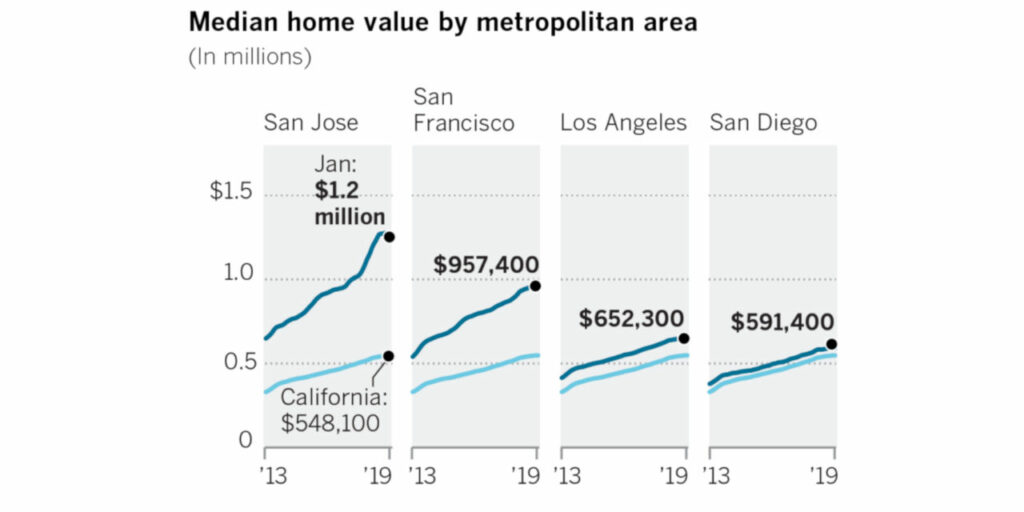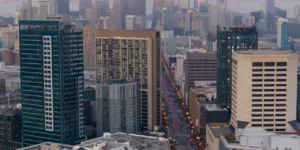The San Francisco Bay Area comprises the city of San Francisco and its surrounding counties. In September 2019, the median house price slid 5.4%, year-on-year. According to the California Association of Realtors (C.A.R.), the median price for a home in the greater Bay Area is $880,000. According to the data, the 12-month moving average – from September to September – reflects a sharp decline in real estate prices.
Most everybody understands that the prices of real estate in the Bay Area are disproportionately expensive, evidenced by the fact that even techies earning six figures can’t afford to purchase these properties.
While Silicon Valley’s economy is predicated on the success of big tech, the metropolis cannot survive without service industry personnel – teachers, waiters, servers, firefighters, and other civil servants. In San Francisco alone, the median home value is $1.34 million, with a down payment in the region of $250,000 needed to secure a mortgage. In many other parts of the country, this down payment could purchase a property outright.
There are many cases of software engineers, programmers, and tech professionals who cannot possibly hope to make ends meet by purchasing real estate in San Francisco. Instead, many professionals are turning to high rentals as an alternative to homeownership. It’s certainly not a desirable situation, but people are often left with no choice. Fortunately, the mayor of San Francisco, London Breed, and the mayor of Oakland, Libby Schaaf, are among many elected officials pushing for a greater focus on the construction of new and affordable housing.
A recent report by KALW local public radio in San Francisco focuses on the dual problems of increasing homelessness and exorbitant housing costs. A government proposal known as PROP E attempts to address the problem by redeveloping public land and transforming it into affordable housing. San Francisco struggles with affordable housing to the point where some 67% of teachers are considered ‘rent burdened’, indicating that 30% + of their income goes towards paying rent. PROP E is being billed as the best way to change the current planning code and deliver affordable housing for teachers, but this only addresses one segment in the broad-spectrum of rent burdened individuals.
How Can Private Developers Help with Affordable Housing in the Greater Bay Area?

Private developers are eager to buy property, renovate it, and lease it at high cost to renters. That tends to be the norm across the country. However, in the greater Bay Area where costs are so high, there is a large untapped market of middle and low-income earners who cannot afford to pay these high rentals.
This presents a quandary since new housing units are being built, but they remain inaccessible to those who need them most. Enter Danny Haber, an innovative thinker, real estate developer and problem solver. His company, oWOW has been working hard to address the need for affordable housing. The company utilizes a vertically integrated development system to build modular units for resale to developers, and to construct net new housing for consumers.
Already, oWOW has completed construction at 674 23rd Street, with 24 units now leased to consumers. These live/work units are ideal for the modern-day workforce. The tenants in the building cut across the demographic and include self-styled entrepreneurs, artists, and people working for small, medium, and large businesses.
The 674 23rd Street development in Oakland was made possible due to the fact that the building had been vacant for several years, following a fire in a neighboring building. Danny Haber purchased the building and renovated the apartments using a unique design and development process known as MacroUnits. These flexible spaces allow developers to convert the units into multi-bedroom/bathroom units, within a set square footage.
These repeatable designs can be fully customized, saving time, space, and costs in the process. The apartments are designed, developed, and modelled quickly and easily. As a leading Bay Area housing company, oWOW is geared towards the provision of affordable housing for all income levels. The company tackles the housing crisis from a cost perspective, but doesn’t sacrifice quality and luxury in the process.
Other big projects in the oWOW portfolio include 1919 Street market, 316 12th Street, and 960 Howard Street. The LA Times penned an op-ed in March 2019 about proposals from Bay Area politicians to redefine the housing landscape. As an area facing the highest housing costs in the country, the Bay Area also has many positives, notably a thriving technology sector which leads the world and serves as a major employer for scores of people. The State Government is relying on private developers – for-profit and not-for-profit – to assist in resolving the crisis. Developers like Danny Haber are playing their part.








